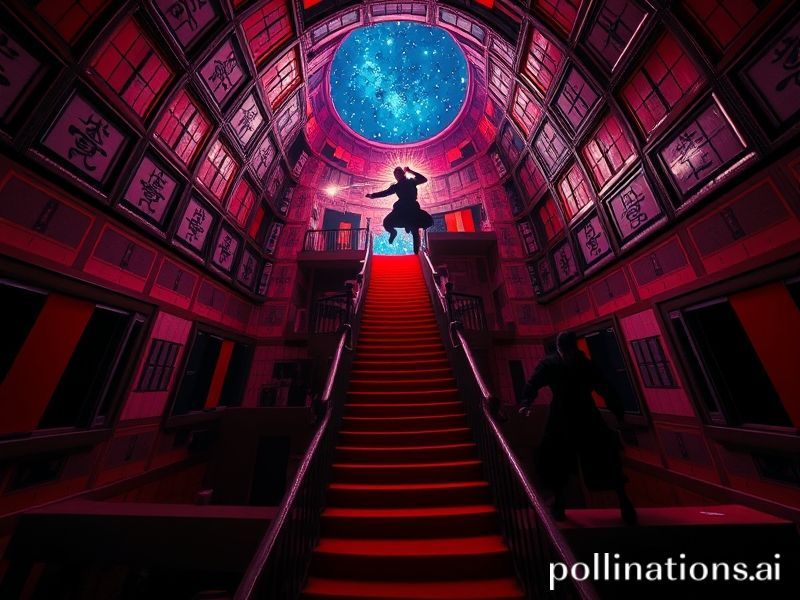Global Siege: How Demon Slayer’s Infinity Castle Became the World’s Newest Superpower
Demon Slayer: Infinity Castle—The Global Siege of a Cartoon Sword Fight
By the time the first teaser for Demon Slayer: Infinity Castle dropped, the planet had already endured two years of plague, three currency crises, and a social-media war whose only casualty was nuance. Naturally, humanity’s reflex was to form orderly queues—Tokyo’s Shinjuku at 4 a.m., São Paulo’s Liberdade by dawn, Paris’s Rue des Petites-Écuries before the boulangeries even hauled out the croissants. One might assume civilization was rationing insulin. Instead, it was jostling for tickets to watch animated teenagers stab demonic PTSD metaphors in a collapsing palace. Priorities, after all, are what separate us from the animals—well, that and cosplay budgets north of a rent payment.
The film trilogy—yes, trilogy, because even cinematic infinity apparently needs a quarterly earnings call—promises to adapt the “Infinity Castle” arc, a narrative labyrinth where floors rearrange like crypto prices. Globally, the announcement landed with the diplomatic weight of a trade accord. Japan’s Ministry of Economy twitched: another Demon Slayer boom could single-handedly nudge GDP by a polite 0.3%. South Korea’s multiplexes pre-booked entire train cars to ship K-pop fans straight into Mugen Train flashbacks. Meanwhile, France declared a national shortage of midnight blue wig dye—Macron’s office neither confirmed nor denied strategic stockpiles.
Streaming platforms from Manila to Mexico City are already bracing for what analysts politely term “a tidal wave of eyeballs” and what IT departments call “the night we pretend the servers were hacked by North Korea again.” Netflix, Crunchyroll, and Disney+ Hotstar have begun the delicate dance of territorial exclusivity, a choreography reminiscent of Cold-War Berlin but with more pastel key art. The geopolitics of subtitles alone could power a graduate seminar: will the Portuguese localizations keep the original honorifics, or will Brazilian audiences awaken to find Tanjiro calling Inosuke “bro”? Tear-gas levels of Twitter discourse await.
Financially, the franchise is approaching sovereign-nation status. The previous film, Mugen Train, earned US$507 million worldwide—enough to vaccinate a mid-sized republic or, more realistically, fund another Fast & Furious sequel. Analysts at Morgan Stanley (who clearly missed their true calling as otaku bloggers) predict Infinity Castle could crack the billion-dollar ceiling, thereby proving that the fastest way to soft power is still a pretty boy with a Nichirin blade and unresolved grief. The Bank of Japan is rumored to be studying Demon Slayer bonds. Yield to maturity, one assumes, includes a free keychain.
Soft power aside, the real international miracle is the merchandise pipeline. Vietnam’s factories pivoted from fast-fashion to Tanjiro earrings overnight; Bangladeshi textile mills are reportedly weaving haori patterns into commemorative hijabs. In the United States, Target’s Halloween aisle has already surrendered an entire gondola to plastic katanas that will, as night follows day, end up in TSA contraband bins by November. Climate activists calculate the carbon footprint of every glow-in-the-dark Nezuko boxset; their spreadsheets resemble the Infinity Castle itself—endless, recursive, faintly demonic.
And yet, beneath the cynical ledger of dollars and data, something stubbornly human persists. In Kyiv, a bomb-shelter screening of the trailer drew applause louder than the air-raid sirens. Syrian refugee kids in Istanbul queued for a fan-dubbed bootleg because the official Arabic release is still negotiating whether to censor the blood—never mind the actual blood outside. Somewhere in Lagos, an artist airbrushes Tanjiro’s checkered coat onto a danfo bus, turning commuter chaos into moving pop-art. The world may be burning, but it’s burning with impeccable animation.
So when Infinity Castle finally detonates across screens this winter, remember: you’re not just watching a shonen protagonist slice through trauma in fabulous 4K. You’re witnessing the rare moment when the planet synchronizes its watch to a single piece of escapism, like New Year’s Eve but with more merchandising tie-ins. The demons, it turns out, aren’t the ones with fangs and fabulous hair; they are inflation, war, algorithmic despair. For two-ish hours per installment, humanity agrees to pretend swords still solve something. Then the credits roll, the lights come up, and we shuffle back into the larger, uncooler infinity we’ve built for ourselves. Bring snacks; the concession stand now accepts crypto.







